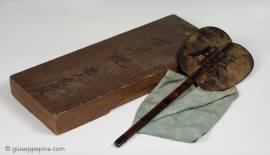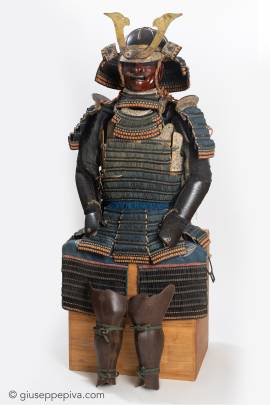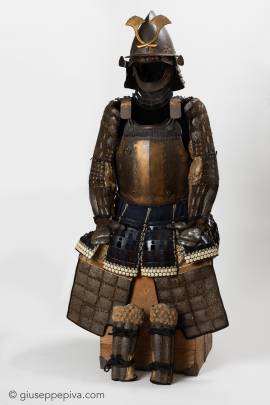Muromachi to Momoyama period, 16th centuryLacquered wood and bamboo, 46 x 21 cmLenght: 50 cm The various implements used by samurai commanders to signal orders on the batter field or to direct troop movements were referred to as jineigu. Among them, the gunbai uchiwa, a fixed fan, was the equipment that was used by generals and daimyō and hence became a symbol of power.Early gunbai were rather simple, with sober decoration. This one, as most of those from the Muromachi period, has a rather small flat area and a long bamboo handle in order to be easily used on the batter field. The flat...
WORKS FOR SALE
Azuchi-Momoyama period (1575 - 1615)16th century, refurbished in 1796 Provenance:Takekoshi Dochin (died 1556)Matsuoka OshikasukeInscribed under one sode: 寛政癸戌春被属修理 / 竹腰道鎮公古甲 松岡牡鹿輔 + kaoAccording to a label stitched inside one of the sode, the armor was repaired in 1796. The inscription is signed by Matsuoka Oshikasuke, a scholar of the Tokugawa clan, retainer in Nagoya, student of Motoori Norinaga.Takekoshi Dochin, whose name is written by Oshikasuke in his inscription, was a general commander of the Sengoku period, lord of the Ogaki castle in Mino. He died in 1556 during the battle of...
Nanban Tosei GusokuIncorporating a cabasset helmetEarly Edo period, 16th-17th century European armor was brought into Japan through trade with Spain and Portugal in the 16th century. With the introduction of firearms, the Japanese would, in fact, imitate those suits of armor, designed to deflect bullets, and began producing them in Japan, which were collectively called nanban (“Southern barbarian”) indicating a foreign origin.This rare composite authentic Japanese samurai armor incorporates interesting elements made in this style as well as an original European helmet...
Copyright © 2016 - giuseppe piva - VAT: 05104180962










